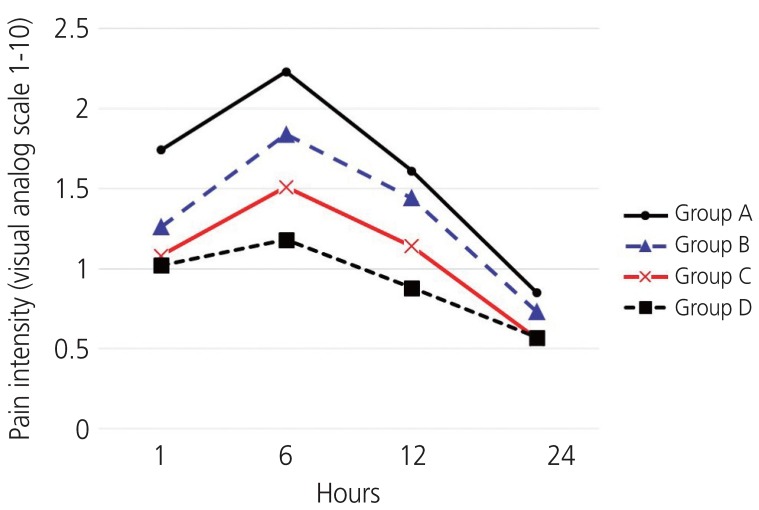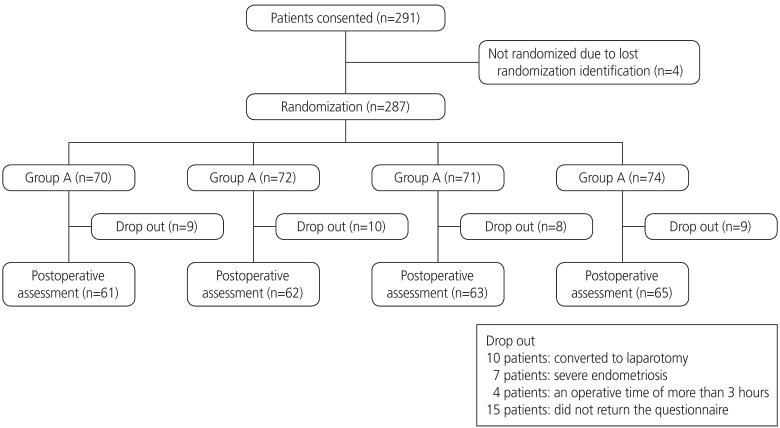1. Grace PA, Quereshi A, Coleman J, Keane R, McEntee G, Broe P, et al. Reduced postoperative hospitalization after laparoscopic cholecystectomy. Br J Surg 1991;78:160-162. PMID:
1826624.


2. Ortega AE, Hunter JG, Peters JH, Swanstrom LL, Schirmer B. Laparoscopic Appendectomy Study Group. A prospective, randomized comparison of laparoscopic appendectomy with open appendectomy. Am J Surg 1995;169:208-212. PMID:
7840381.


3. Alexander JI. Pain after laparoscopy. Br J Anaesth 1997;79:369-378. PMID:
9389858.


4. Cason CL, Seidel SL, Bushmiaer M. Recovery from laparoscopic cholecystectomy procedures. AORN J 1996;63:1099-1103. PMID:
8771319.


5. Madsen MR, Jensen KE. Postoperative pain and nausea after laparoscopic cholecystectomy. Surg Laparosc Endosc 1992;2:303-305. PMID:
1341550.

6. Tsai HW, Wang PH, Yen MS, Chao KC, Hsu TF, Chen YJ. Prevention of postlaparoscopic shoulder and upper abdominal pain: a randomized controlled trial. Obstet Gynecol 2013;121:526-531. PMID:
23635614.


7. Ure BM, Troidl H, Spangenberger W, Dietrich A, Lefering R, Neugebauer E. Pain after laparoscopic cholecystectomy. Intensity and localization of pain and analysis of predictors in preoperative symptoms and intraoperative events. Surg Endosc 1994;8:90-96. PMID:
8165491.


8. Lee DH, Song T, Kim KH, Lee KW. Incidence, natural course, and characteristics of postlaparoscopic shoulder pain. Surg Endosc 2018;32:160-165. PMID:
28643053.


9. Jackson SA, Laurence AS, Hill JC. Does post-laparoscopy pain relate to residual carbon dioxide? Anaesthesia 1996;51:485-487. PMID:
8694166.


10. Coventry DM. Anaesthesia for laparoscopic surgery. J R Coll Surg Edinb 1995;40:151-160. PMID:
7616466.

11. Korell M, Schmaus F, Strowitzki T, Schneeweiss SG, Hepp H. Pain intensity following laparoscopy. Surg Laparosc Endosc 1996;6:375-379. PMID:
8890423.


12. Song T, Kim KH, Lee KW. The intensity of postlaparoscopic shoulder pain is positively correlated with the amount of residual pneumoperitoneum. J Minim Invasive Gynecol 2017;24:984-989.e1. PMID:
28602786.


13. Labaille T, Mazoit JX, Paqueron X, Franco D, Benhamou D. The clinical efficacy and pharmacokinetics of intraperitoneal ropivacaine for laparoscopic cholecystectomy. Anesth Analg 2002;94:100-105. PMID:
11772809.


14. Lee IO, Kim SH, Kong MH, Lee MK, Kim NS, Choi YS, et al. Pain after laparoscopic cholecystectomy: the effect and timing of incisional and intraperitoneal bupivacaine. Can J Anaesth 2001;48:545-550. PMID:
11444448.


15. Narchi P, Benhamou D, Fernandez H. Intraperitoneal local anaesthetic for shoulder pain after day-case laparoscopy. Lancet 1991;338:1569-1570. PMID:
1683981.


16. Kelly MC. An assessment of the value of intraperitoneal bupivacaine for analgesia after laparoscopic sterilisation. Br J Obstet Gynaecol 1996;103:837-839. PMID:
8760719.


17. Benhamou D, Narchi P, Mazoit JX, Fernandez H. Postoperative pain after local anesthetics for laparoscopic sterilization. Obstet Gynecol 1994;84:877-880. PMID:
7936530.

18. Loughney AD, Sarma V, Ryall EA. Intraperitoneal bupivacaine for the relief of pain following day case laparoscopy. Br J Obstet Gynaecol 1994;101:449-451. PMID:
8018622.


19. Shaw IC, Stevens J, Krishnamurthy S. The influence of intraperitoneal bupivacaine on pain following major laparoscopic gynaecological procedures. Anaesthesia 2001;56:1041-1044. PMID:
11703235.


20. Kaloo P, Armstrong S, Kaloo C, Jordan V. Interventions to reduce shoulder pain following gynaecological laparoscopic procedures. Cochrane Database Syst Rev 2019;CD011101. PMID:
30699235.



21. Phelps P, Cakmakkaya OS, Apfel CC, Radke OC. A simple clinical maneuver to reduce laparoscopy-induced shoulder pain: a randomized controlled trial. Obstet Gynecol 2008;111:1155-1160. PMID:
18448749.


22. Mouton WG, Bessell JR, Otten KT, Maddern GJ. Pain after laparoscopy. Surg Endosc 1999;13:445-448. PMID:
10227938.


23. Fredman B, Jedeikin R, Olsfanger D, Flor P, Gruzman A. Residual pneumoperitoneum: a cause of postoperative pain after laparoscopic cholecystectomy. Anesth Analg 1994;79:152-154. PMID:
8010427.


24. Alexander JI, Hull MG. Abdominal pain after laparoscopy: the value of a gas drain. Br J Obstet Gynaecol 1987;94:267-269. PMID:
2952161.


25. Abbott J, Hawe J, Srivastava P, Hunter D, Garry R. Intraperitoneal gas drain to reduce pain after laparoscopy: randomized masked trial. Obstet Gynecol 2001;98:97-100. PMID:
11430964.


26. Esmat ME, Elsebae MM, Nasr MM, Elsebaie SB. Combined low pressure pneumoperitoneum and intraperitoneal infusion of normal saline for reducing shoulder tip pain following laparoscopic cholecystectomy. World J Surg 2006;30:1969-1973. PMID:
17043939.


27. Nursal TZ, Yildirim S, Tarim A, Noyan T, Poyraz P, Tuna N, et al. Effect of drainage on postoperative nausea, vomiting, and pain after laparoscopic cholecystectomy. Langenbecks Arch Surg 2003;388:95-100. PMID:
12684804.


28. Palmes D, R├Čttgermann S, Classen C, Haier J, Horstmann R. Randomized clinical trial of the influence of intraperitoneal local anaesthesia on pain after laparoscopic surgery. Br J Surg 2007;94:824-832. PMID:
17571296.


29. Swift G, Healey M, Varol N, Maher P, Hill D. A prospective randomised double-blind placebo controlled trial to assess whether gas drains reduce shoulder pain following gynaecological laparoscopy. Aust N Z J Obstet Gynaecol 2002;42:267-270. PMID:
12230061.


30. Tsai HW, Chen YJ, Ho CM, Hseu SS, Chao KC, Tsai SK, et al. Maneuvers to decrease laparoscopy-induced shoulder and upper abdominal pain: a randomized controlled study. Arch Surg 2011;146:1360-1366. PMID:
22184293.


31. Rettenmaier MA, Micha JP, Lopez KL, Wilcox AM, Goldstein BH. A prospective, observational trial assessing the efficacy of abdominal compression in reducing laparoscopic-induced shoulder pain. Surg Innov 2017;24:552-556. PMID:
28677420.


32. Pasqualucci A, de Angelis V, Contardo R, Col├▓ F, Terrosu G, Donini A, et al. Preemptive analgesia: intraperitoneal local anesthetic in laparoscopic cholecystectomy. A randomized, double-blind, placebo-controlled study. Anesthesiology 1996;85:11-20. PMID:
8694355.


33. Tsimoyiannis EC, Siakas P, Tassis A, Lekkas ET, Tzourou H, Kambili M. Intraperitoneal normal saline infusion for postoperative pain after laparoscopic cholecystectomy. World J Surg 1998;22:824-828. PMID:
9673554.


34. Tusman G, B├Čhm SH, Vazquez de Anda GF, do Campo JL, Lachmann B. ŌĆśAlveolar recruitment strategyŌĆÖ improves arterial oxygenation during general anaesthesia. Br J Anaesth 1999;82:8-13. PMID:
10325828.


35. Magnusson L, Tenling A, Lemoine R, H├Čgman M, Tyd├®n H, Hedenstierna G. The safety of one, or repeated, vital capacity maneuvers during general anesthesia. Anesth Analg 2000;91:702-707. PMID:
10960404.


36. Ricard JD. Barotrauma during mechanical ventilation: why arenŌĆÖt we seeing any more? Intensive Care Med 2004;30:533-535. PMID:
14985954.


37. Ryu K, Choi W, Shim J, Song T. The impact of a pulmonary recruitment maneuver to reduce post-laparoscopic shoulder pain: a randomized controlled trial. Eur J Obstet Gynecol Reprod Biol 2017;208:55-60. PMID:
27889667.


38. Sharami SH, Sharami MB, Abdollahzadeh M, Keyvan A. Randomised clinical trial of the influence of pulmonary recruitment manoeuvre on reducing shoulder pain after laparoscopy. J Obstet Gynaecol 2010;30:505-510. PMID:
20604657.



























